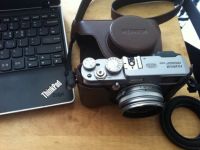-
Start
-
Donghaewon
-
Royal Tomb of King Muryeong
-
Gongju Hanok Village
-
Gongju National Museum
-
Muin Hotel
-
Cherry Blossom Festival
-
Donghak Temple
-
Finish
At least 18 National Treasures, Real Treasure House 'Gongju National Museum'
Wherever you travel, it's the best way to visit a local museum to get to know well about the region where you visit. It clearly shows the history and culture of the region. If you want to study the linkage between Baekje Kingdom and Gongju, you need to go to Gongju National Museum, because Gongju was once the capital of Baekje. The museum preserves 4,600 of Baekje artifacts. They include 18 national treasures and 4 treasures. Calling the museum a treasure house is no hyperbole.
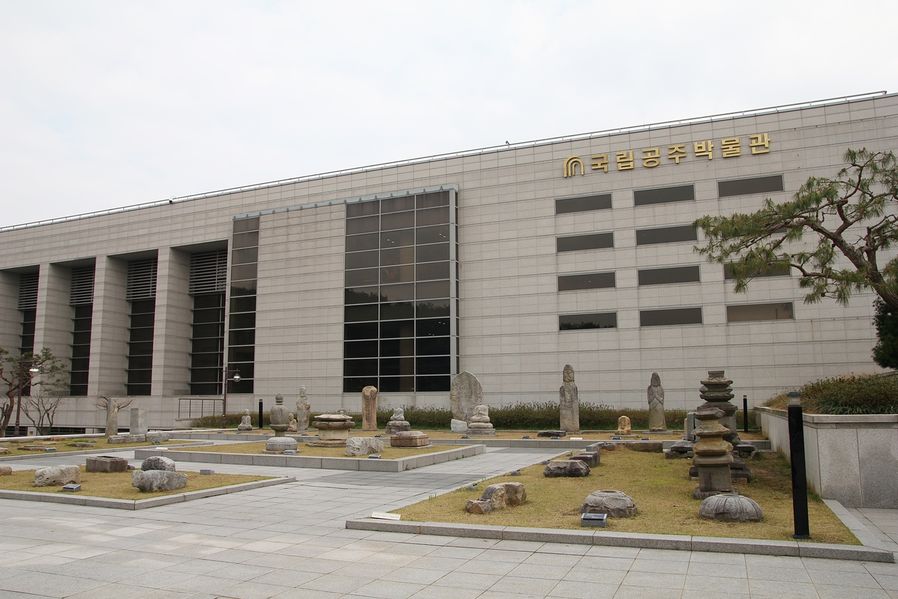
Canon EOS 550D | f/8.0 | iso 100 | 2015:04:08 16:29:43 | Flash did not fire, compulsory flash mode | 17mm
Baekje is divided into three periods; Hanseong, Ungjin, and Sabi. Ungjin is present Gongju. In 475, King Munju moved the capital to Ungjin because of King Jangsu's southward expansion policy and continued Ungjin period for 64 years. The royal tomb of King Muryeong which is the tomb of king and queen was built in this period. This tomb has tremendous historical significance, because it’s the first tomb that we can know who is buried among tombs made in the period of the Three Kingdoms. There are rows of stone relic and stone pagoda outside the museum. I’m looking forward to see how inside of the museum is.

Canon EOS 550D | f/4.0 | iso 100 | 2015:04:08 15:49:29 | Flash did not fire, compulsory flash mode | 17mm
Red blossoms of cherry tree at the entrance are so beautiful. Usually they flower in white but these are red. What a beautiful blossoms! I will plant them in my front yard.
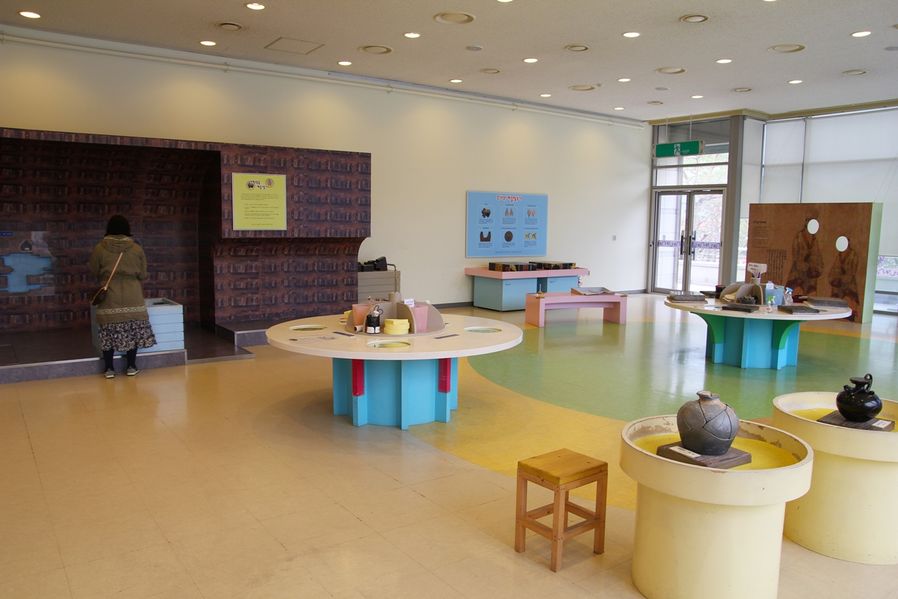
Canon EOS 550D | f/5.0 | iso 250 | 2015:04:08 15:54:53 | Flash did not fire, compulsory flash mode | 17mm
Before the tour of main gallery, there is a Korean culture experience hall across the special gallery. This space allows you to experience various Korean cultures with children. Let's see what they are.
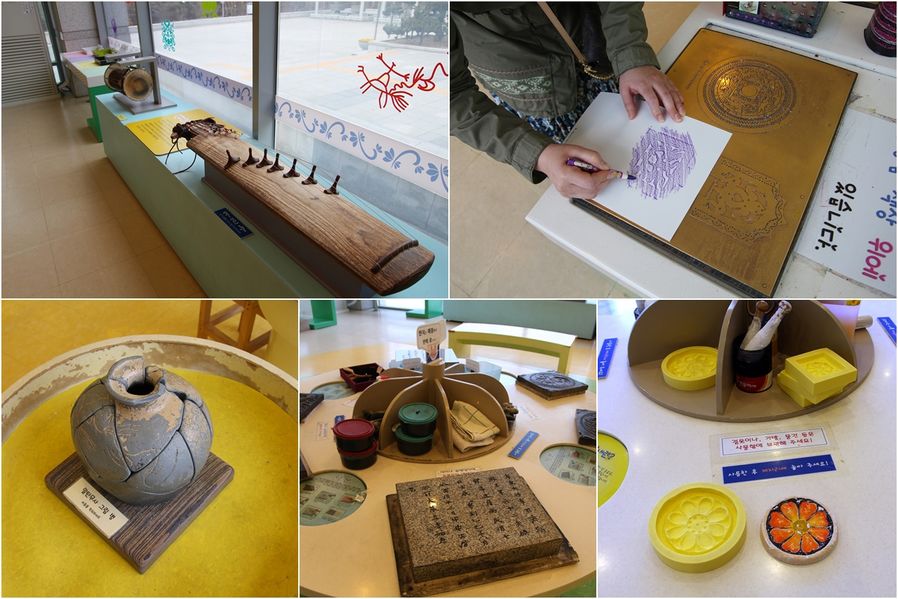
You can touch Korean traditional instruments like Gayageum or Janggu in person. To both children and adults, there are interesting experiences such as doing the frottage, putting the pieces of an artifact together, making a rubbing inscription stone of excavated from the King Muryeong’s tomb, making the highlight of decoration on roof tiles with clay and piling up bricks from the tomb.
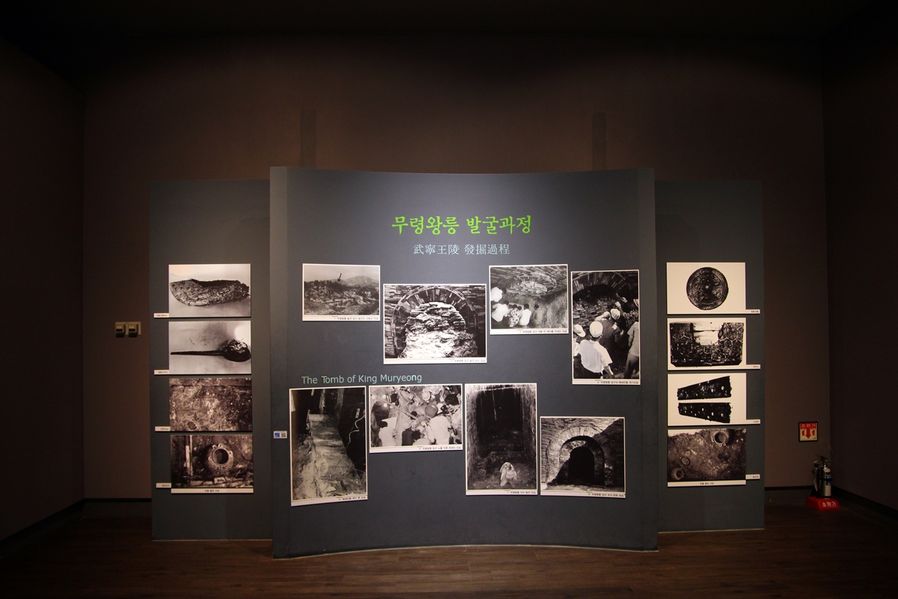
Canon EOS 550D | f/3.2 | iso 1000 | 2015:04:08 16:01:12 | Flash did not fire, compulsory flash mode | 17mm
I entered the main gallery, royal tomb of Muryeong gallery on the first floor. In the summer of 1971, Songsanri tombs no.5 and no.6 tombs were discovered accidentally when installing pipes. They were found in perfect condition. I can see the amazing digging process of those days by pictures.
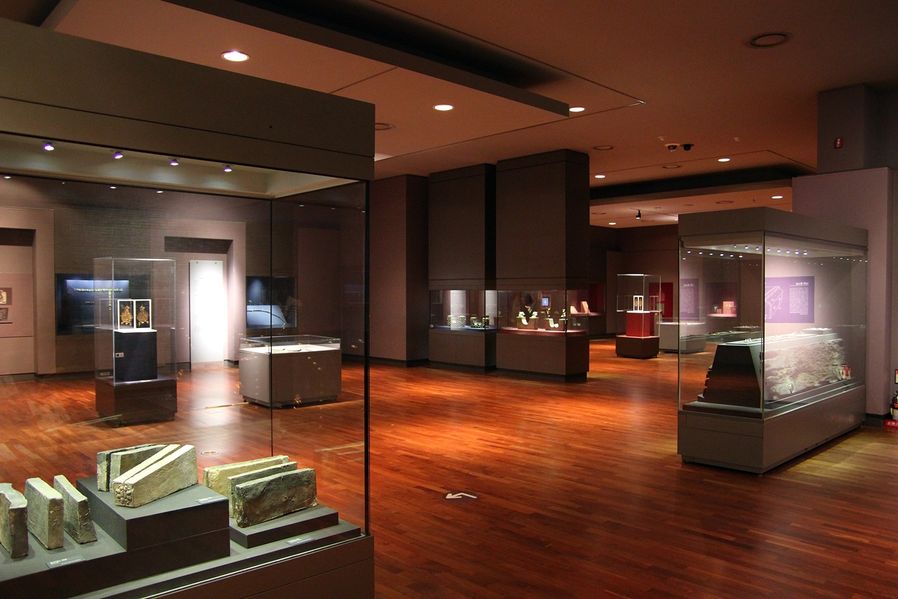
Canon EOS 550D | f/3.2 | iso 2500 | 2015:04:08 16:03:24 | Flash did not fire, compulsory flash mode | 17mm
Students who came on a school trip stormed and got out of the gallery and it's empty. Now it's my turn. First, ‘Myojeon(Bricks)’ which have supported the tomb for 1,500 years catch my eyes.(Left) The Myojeons that have supported the wall are shaped in square and ones have supported the roof have different size according to round shape. I can find the delicate spirit of architecture and art of the Baekje people.
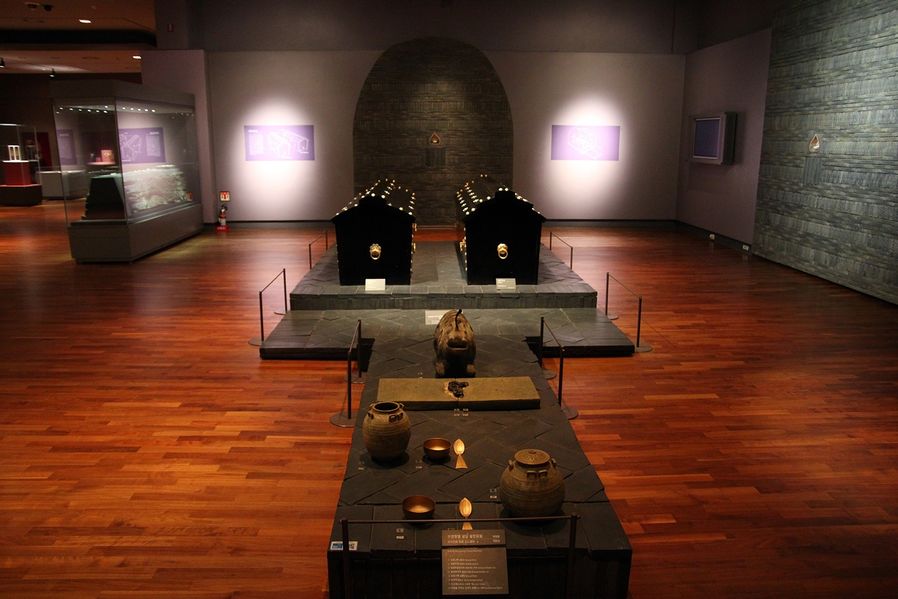
Canon EOS 550D | f/3.2 | iso 2000 | 2015:04:08 16:02:42 | Flash did not fire, compulsory flash mode | 17mm
When you enter the entrance, you would see the floor of the royal tomb of King Muryeong. It is restored as it was discovered. Around the first exit, there are copper bowls, spoons and chopsticks, and jars used by the king. Myojiseok and Osujeon are put right behind them. This inscription stone is very important that it shows who was buried here. Again, it’s the first stone that we can know who is buried in this tomb among ones made in the period of the Three Kingdoms, so it was designated as a national treasure.
Osujeon is a Chinese iron coin. It means people need to pay for the land where the tomb is situated with this coin to gods of land. It reflects the spirit of the age that irrespective of rank, everyone should pay for what they want to get. Right behind, there is an imaginary creature, 'Jinmyosu' that guards the tomb. I will show actual features little later.
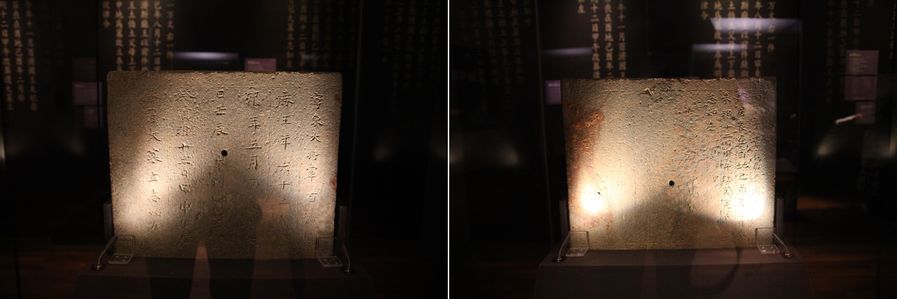
Canon EOS 550D | f/3.2 | iso 2000 | 2015:04:08 16:01:40 | Flash did not fire, compulsory flash mode | 17mm
The picture above is real founded Myojiseok(Inscription stone). It's designated as the National Treasure No.163. Left one belongs to the king and right one does to the queen.
It’s written on the stone that ‘King Sama of Baekje passed away on May 7th in the year of Gyemyo(523) when he was 62 years old and was buried in Daemyo(Royal mausoleum) according to custom on August 12th in the year of Eulsa(525).’ The date when she was buried in this tomb is written on the queen’s stone, as well.
Another interesting thing is behind the queen's memorial stone. It's written on the stone that she bought the site of tomb from god of land(土地神). It seems the god of land really has protected the tomb, because this tomb is the only one that remained in perfection. Other toms of Baekje were robbed.
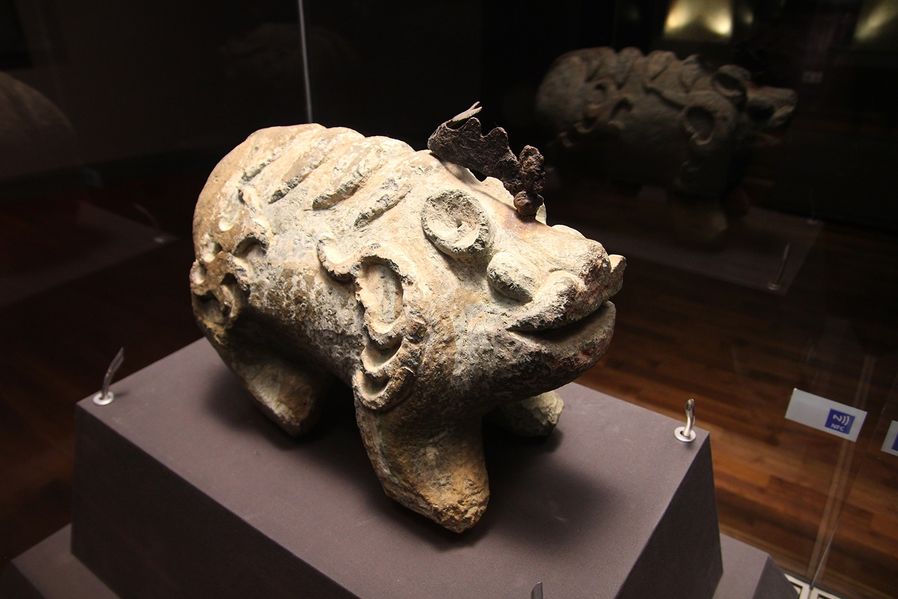
Canon EOS 550D | f/3.2 | iso 1250 | 2015:04:08 16:02:20 | Flash did not fire, compulsory flash mode | 17mm
This is the very 'Jinmyosu'(National Treasure Number 162) that we watched before. It’s the animal drawn on the pamphlet and ticket of Gongju National Museum. It means that this unrealistic and mystical animal protect people buried in the tomb. It's originated from a Chinese custom. I appreciate that they have been protected for 1,500 years.
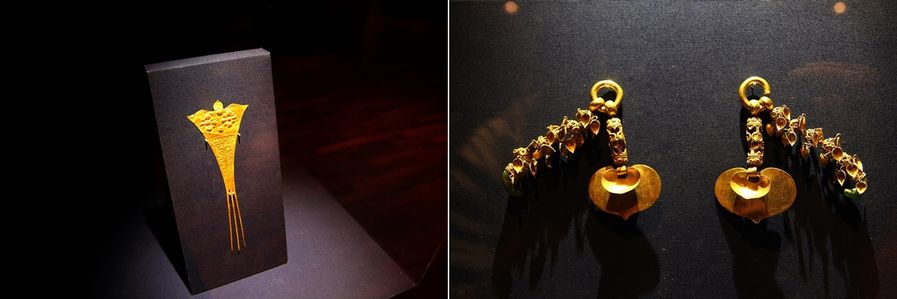
Canon EOS 550D | f/3.2 | iso 1600 | 2015:04:08 16:04:01 | Flash did not fire, compulsory flash mode | 17mm
Various large amounts of golden ornaments were excavated. On the left side, it's a golden king's hairpin(National Treasure No.159). It's a pair of golden king's earrings(National Treasure No.156) on the right. They are all the king's ornaments. The gold which remains shiny over the years is still so beautiful. They prove how the workmanship of metal was developed in the period of the Three Kingdoms.
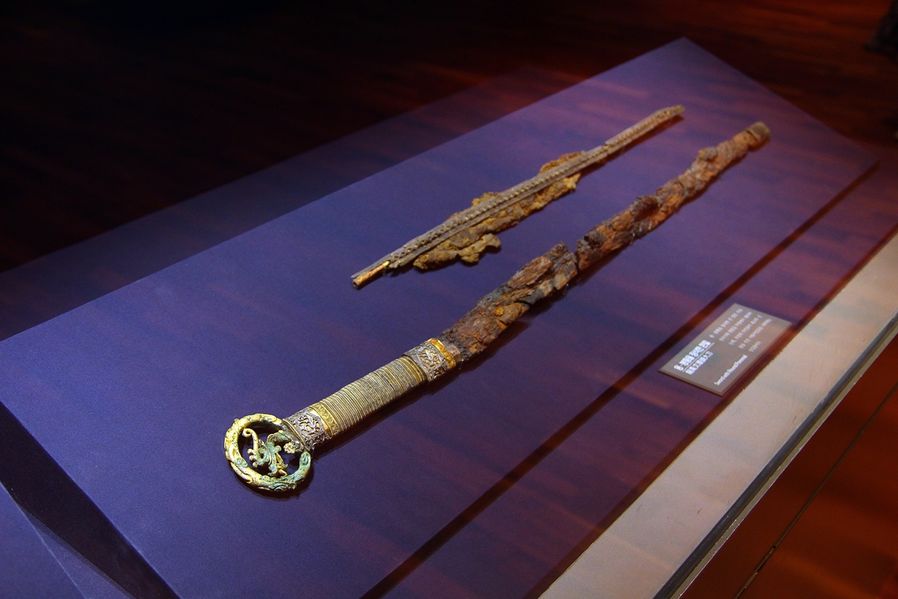
Canon EOS 550D | f/3.2 | iso 1000 | 2015:04:08 16:04:53 | Flash did not fire, compulsory flash mode | 25mm
Appropriate-sized long swords with dragon and phoenix in gold are mainly found in tombs of king. It's a symbol that the owner was a person who was in the highest class.
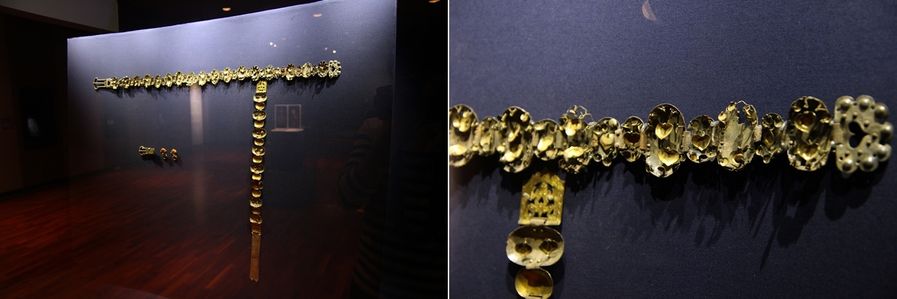
Canon EOS 550D | f/3.2 | iso 1250 | 2015:04:08 16:05:35 | Flash did not fire, compulsory flash mode | 17mm
I've seen relics of Silla Dynasty at Gyeongju National Museum. By looking at these artifacts, we can imagine how much the civilization of Korean Peninsula flourished in the period of the Three Kingdoms. Ornaments of the belt are delicate and beautiful as you see. The origin of heart traces back to the 13th century in Scotland but our ancestors already used it in around 5th and 6th century!
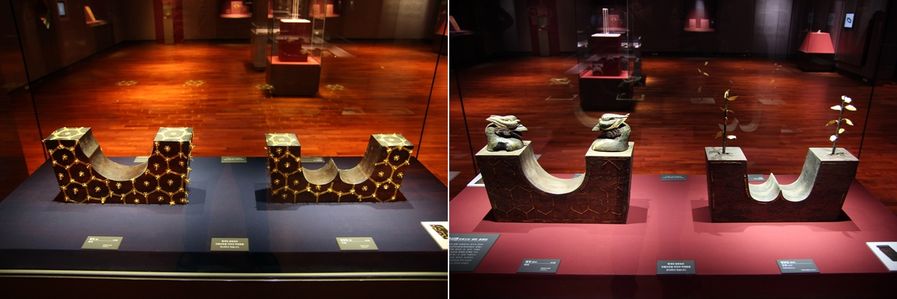
Canon EOS 550D | f/3.2 | iso 1250 | 2015:04:08 16:06:20 | Flash did not fire, compulsory flash mode | 19mm
These are pillows and leg-rests of the king(Left, National Treasure No.165) and queen(Right, National Treasure No.164). They are set in order to fix the posture of laid bodies in a coffin. Everything looks beautiful.
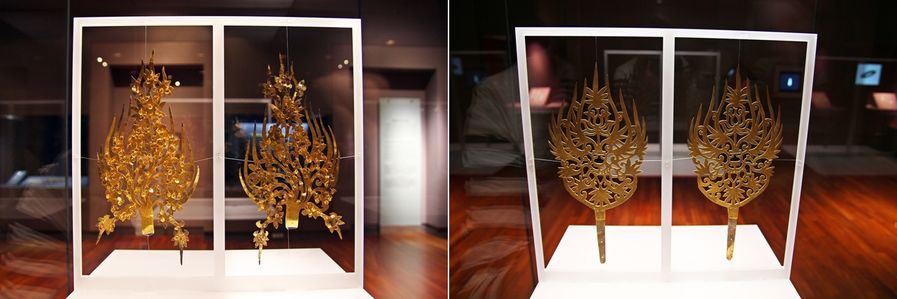
Canon EOS 550D | f/3.2 | iso 640 | 2015:04:08 16:06:53 | Flash did not fire, compulsory flash mode | 17mm
The most impressive artifact in the Gyeongju National Museum was these gold ornaments for the diadem of the queen. It's the best artifact among ones in the royal tomb of King Muryeong. Left ornament is belong to the king (National Treasure No.154) and right one is to the queen(National Treasure No.155). Shiny and bright color and elaborate pattern produce unutterable beauty. The gold ornaments for the diadem of the king and queen look different. It's fun to find and compare differences of their shapes.
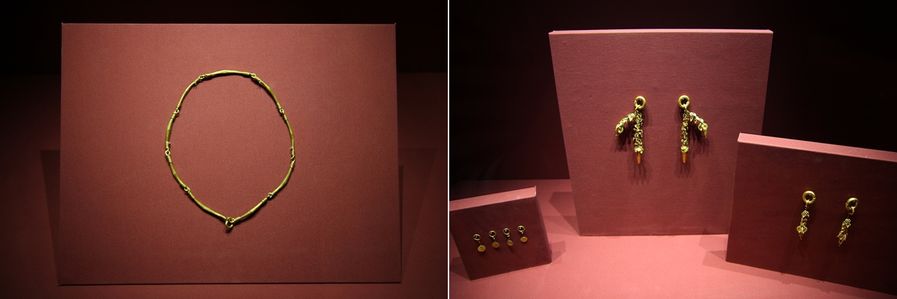
Canon EOS 550D | f/3.2 | iso 400 | 2015:04:08 16:08:12 | Flash did not fire, compulsory flash mode | 28mm
As I watch for a number of national treasures, I'm so excited involuntarily. Jewels in the picture above were used by a queen and they are all national treasures. A gold necklace of the queen on the left side (National Treasure No.158) and gold earrings on the right side (National Treasure No.157) are so beautiful that I should stay longer. They are wonderful.
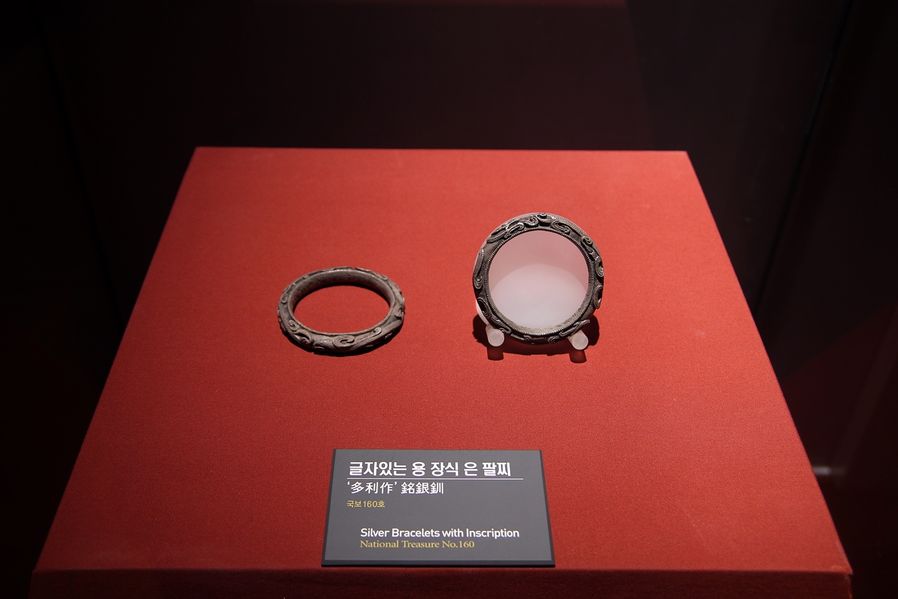
Canon EOS 550D | f/3.2 | iso 200 | 2015:04:08 16:09:54 | Flash did not fire, compulsory flash mode | 24mm
With these silver bracelets (National Treasure No.160) it's possible to see how splendid Baekje was in Ungjin Period. I can get a sense of its cultural climate that the art was important.
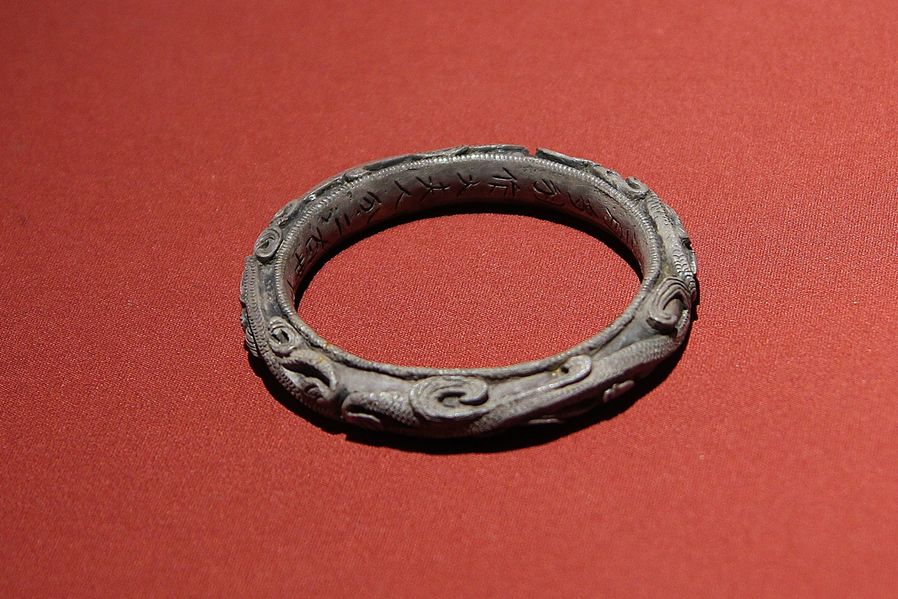
Canon EOS 550D | f/3.2 | iso 500 | 2015:04:08 16:10:03 | Flash did not fire, compulsory flash mode | 50mm
If you peer into the inside of bracelets, they have inscriptions. They say, “A master craftsman whose name is Dari(多利) made these bracelets with 230 Juee for the queen, Daebuin(大夫人) in the year of Gyeongja(520).” You would know who made them and when they were made. 230 Juee must indicate its weight.
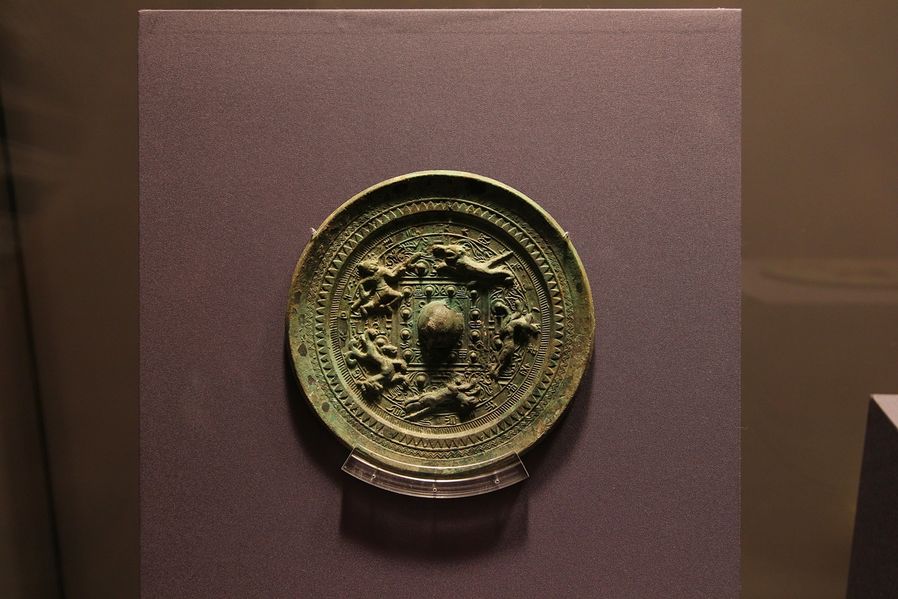
Canon EOS 550D | f/3.5 | iso 800 | 2015:04:08 16:13:04 | Flash did not fire, compulsory flash mode | 25mm
Mirrors used by royal family are extraordinary. 4 animals and 4 gods hunting the animals are painted on the back of this bronze mirror(National Treasure No.161). This kind of mirror features the symbol of rulers' prestige. You would ask yourself why this is a mirror, but a copper plate on the back reflects your face. Most common people in ancient times must have not seen their own faces to their deaths.
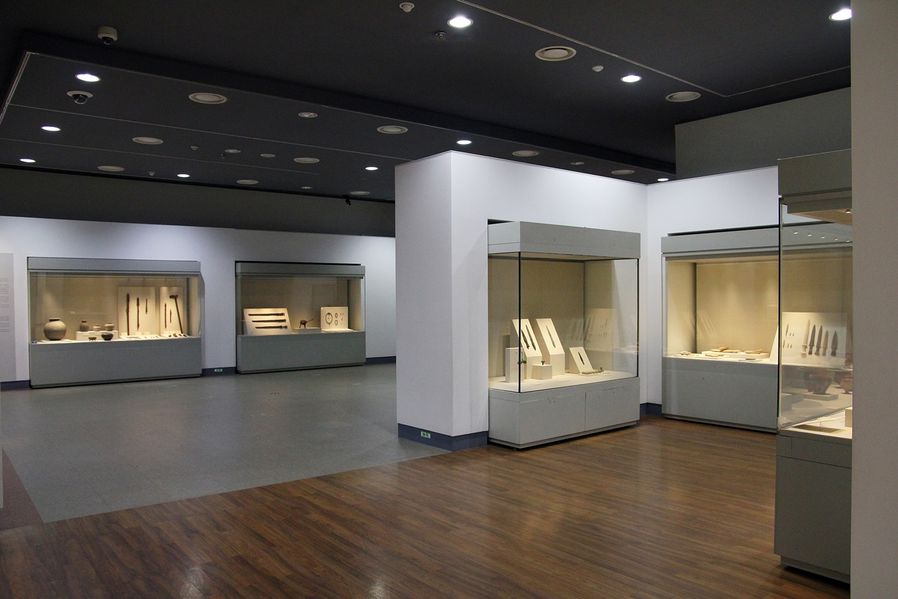
Canon EOS 550D | f/4.0 | iso 1600 | 2015:04:08 16:16:42 | Flash did not fire, compulsory flash mode | 17mm
If the museum has artifacts only form tombs, its name must not be ‘Gongju National Museum’. Other galleries on the second floor include the Ancient Culture Gallery that shows the history and culture of Chungcheongnam-do. Its’ the meaningful place where you can get some idea of Baekje and unified Silla’s general culture.
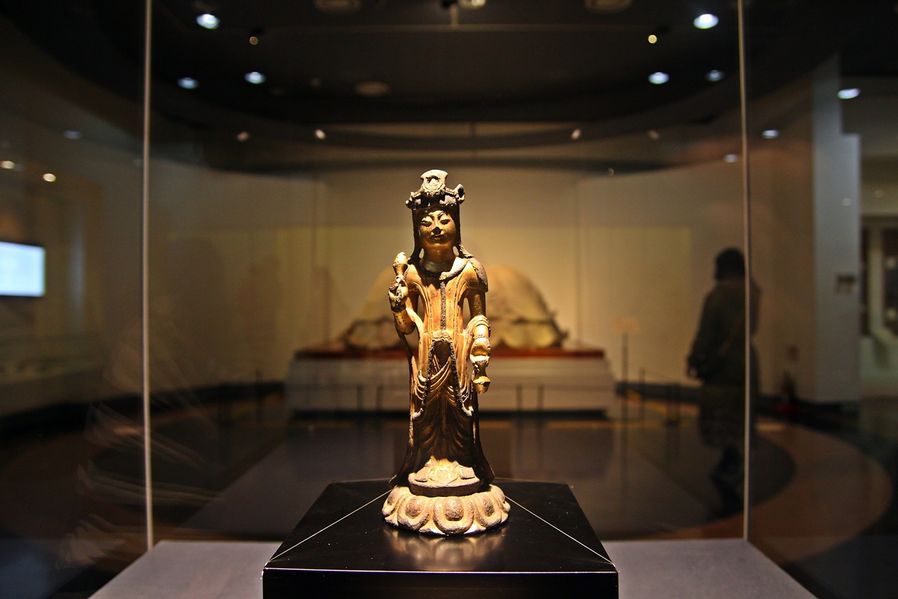
Canon EOS 550D | f/3.2 | iso 1000 | 2015:04:08 16:23:49 | Flash did not fire, compulsory flash mode | 17mm
There are many artifacts that you can catch a glimpse of Buddhist culture of the day. ‘Standing gilt-bronze bodhisattva(National Treasure No.247)’ is outstanding among them. Bosal(Bodhisattva) is a person who seeks for enlightenment of Buddha. The statue of Bodhisattva has delicate and stately beauty. It’s one of the best Baekje statues of the Buddha. Its subtle smile seems beautiful.
As you ponder whose tomb it is, what artifacts are from the tomb, and what is the meaning of them from the entrance of the museum, you would feel like you move one step closer to Baekje culture. The museum might be smaller than other national museums, but it has significance that it’s the only place to get to know about Baekje. It’s hard to talk about Gongju trip without visiting this museum. I recommend you to go visit.
+ Address : 34(360,Ungjin-dong), Gwangwangdanji-gil, Gongju-si, Chungcheongnam-do
+ Telephone : 041-850-6300
+ Open Hour : Weekday 9 am ~ 6 pm, Weekend/Holiday 9 am ~ 7 pm (Monday Closed)
+ Entrance Fee/ Parking Fee : Free
Gukgogae Culture Street and Gongju Jungdong Cathedral with full-blown cherry blossoms
Gukgogae culture street of Gongju has won once the grand prize at the 2010 Good Place Award hosted by the Ministry of culture and tourism. Incheon Art Platform won the second prize. This beautiful street covers from the intersection of Okyong-dong to old Eup Office and particularly the road between Chungnam Museum of History and Gongju Jungdong Cathedral is covered with beautiful cherry blossoms in the spring. Many couples and people in small groups are laughing loudly and taking photos. This road is filled with young energy that reminds me days in my 20s like these people.
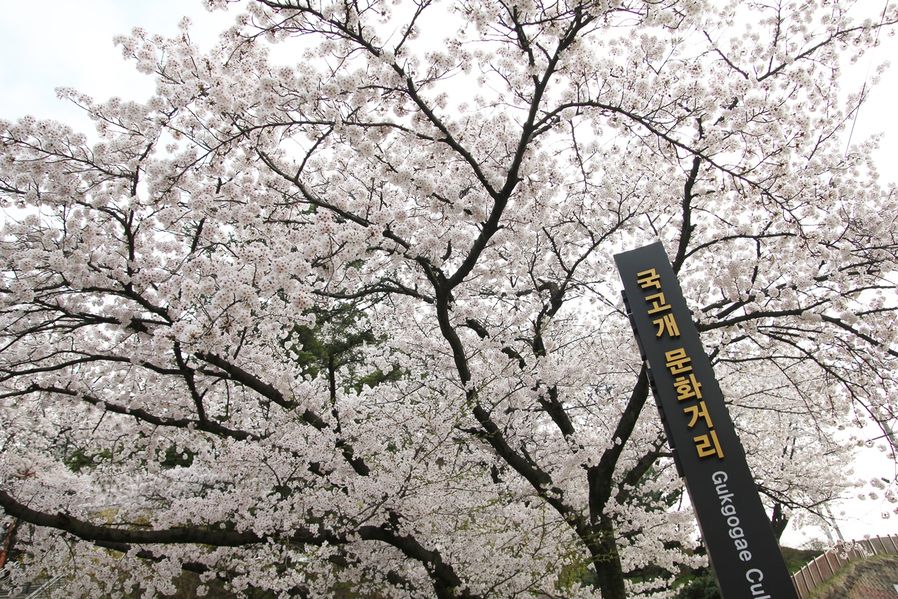
Canon EOS 550D | f/5.0 | iso 100 | 2015:04:08 16:54:49 | Flash did not fire, compulsory flash mode | 17mm
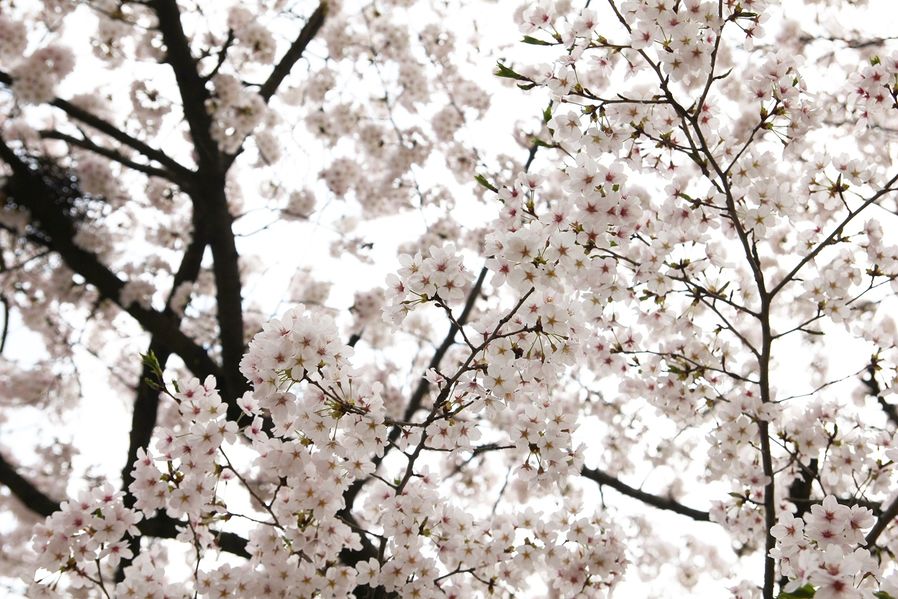
Canon EOS 550D | f/5.0 | iso 100 | 2015:04:08 16:55:05 | Flash did not fire, compulsory flash mode | 40mm
In the warm spring days, Cherry blossoms are in bloom and gone soon. I feel rushed to watch them today, otherwise, I have to wait for a year. Flowers hanging from branches look like masses of popcorn. I feel like grab and eat a handful of them.
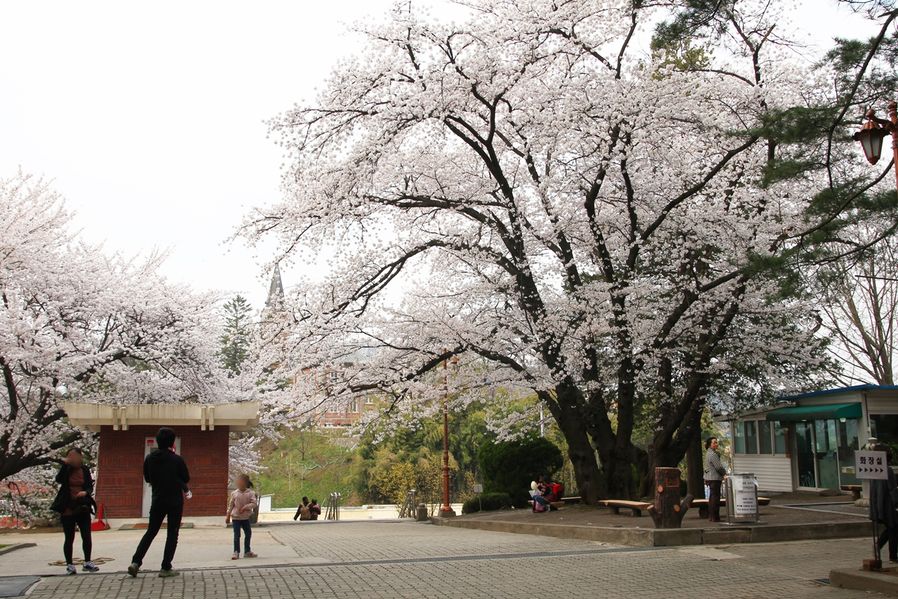
Canon EOS 550D | f/9.0 | iso 100 | 2015:04:08 16:58:21 | Flash did not fire, compulsory flash mode | 20mm
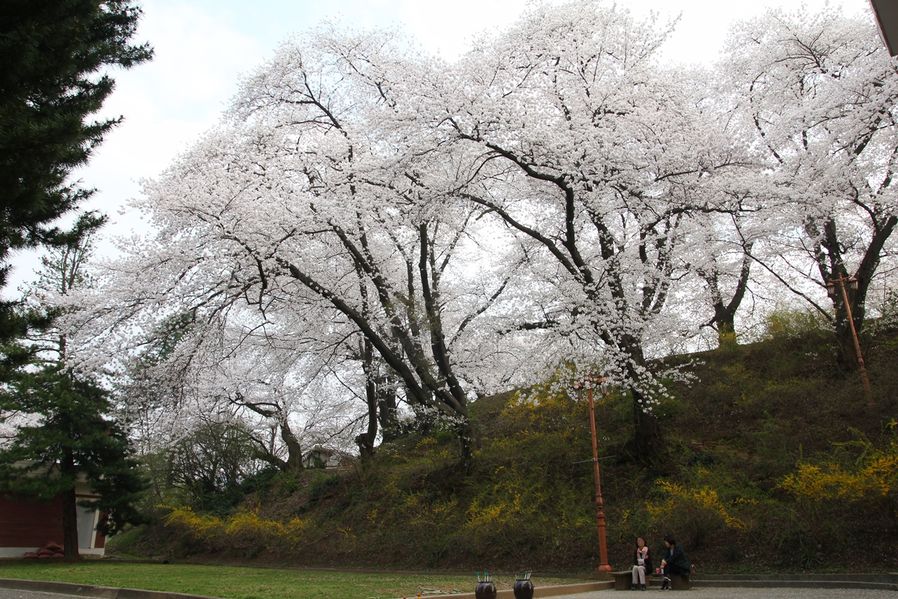
Canon EOS 550D | f/9.0 | iso 100 | 2015:04:08 16:58:42 | Flash did not fire, compulsory flash mode | 17mm
When you go up hill and face to the Chungnam Museum of History, you will see many people taking pictures with their family and couple. Cherry trees grew so high and look beautiful as much as I can’t guess how old the trees are. It's even hard to include them in one shot without a wide-angle lens.
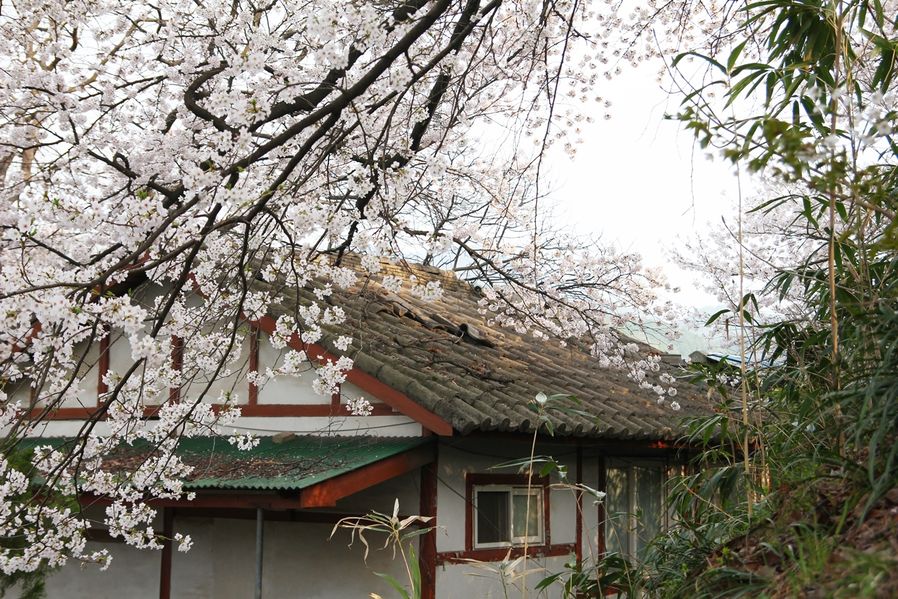
Canon EOS 550D | f/4.0 | iso 100 | 2015:04:08 17:08:48 | Flash did not fire, compulsory flash mode | 36mm
Doesn't this house look great? Nobody lives here but the house has quaint beauty with cherry blossoms hanging from a tiled roof.
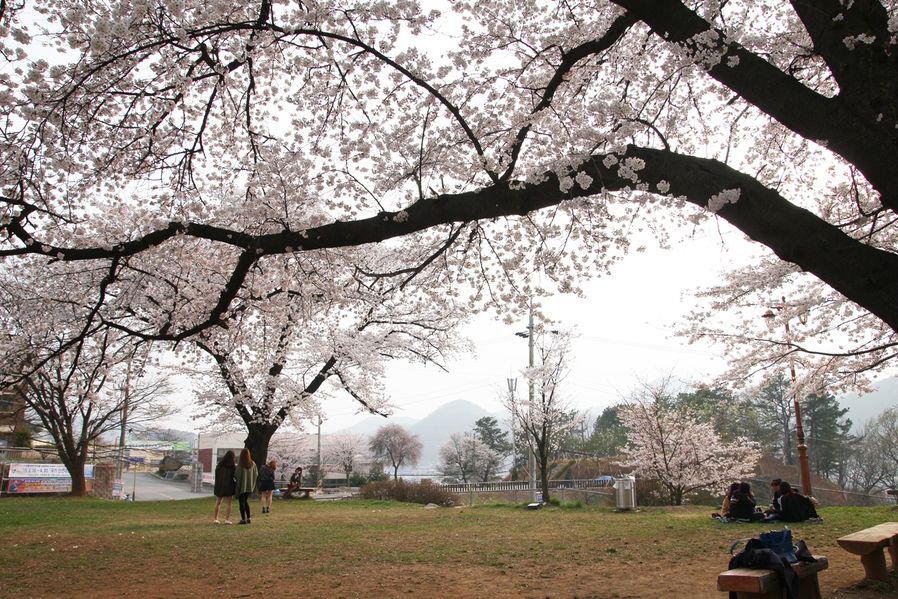
Canon EOS 550D | f/8.0 | iso 100 | 2015:04:08 17:10:01 | Flash did not fire, compulsory flash mode | 17mm
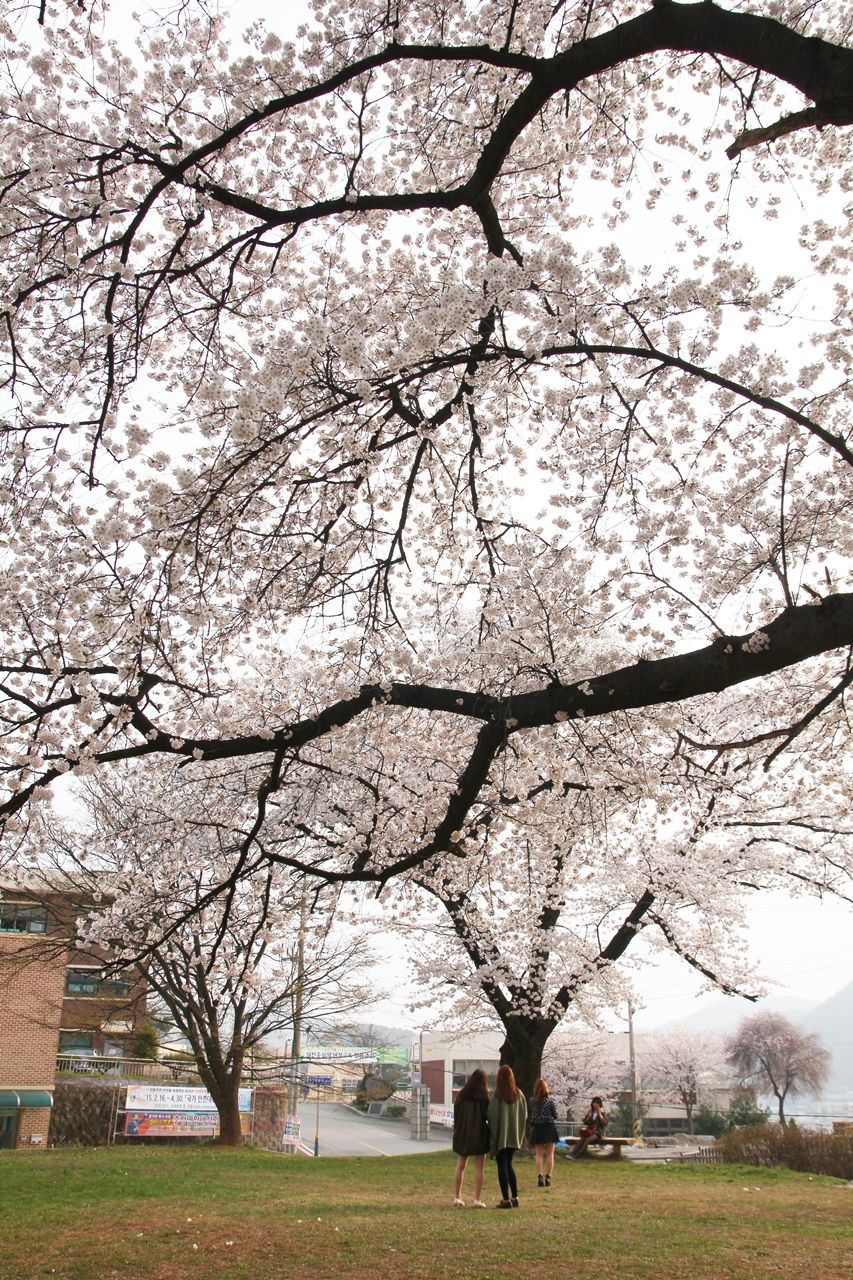
Canon EOS 550D | f/8.0 | iso 100 | 2015:04:08 17:10:09 | Flash did not fire, compulsory flash mode | 21mm
There is green lawn when you go up through a narrow side road beside the museum. There are children who are on picnic with a mat and those who keep taking photos. It's an unusual great experience to see the sky covered with cherry blossoms.
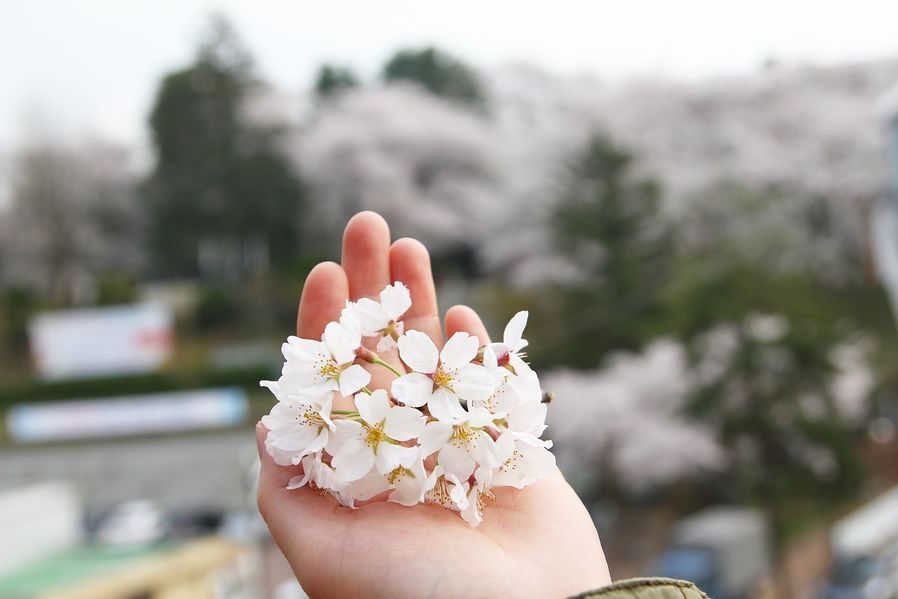
Canon EOS 550D | f/4.5 | iso 100 | 2015:04:08 16:53:10 | Flash did not fire, compulsory flash mode | 34mm
I didn't pluck the flowers! I picked up a handful of cherry blossoms and took a picture with the cherry blossoms on my ears playing like a crazy X. ^^*
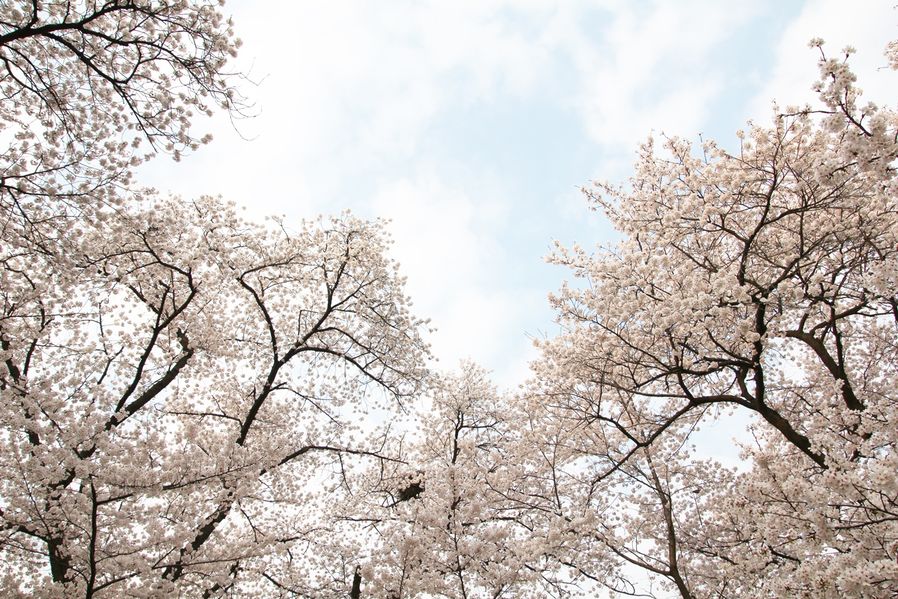
Canon EOS 550D | f/8.0 | iso 100 | 2015:04:08 17:10:44 | Flash did not fire, compulsory flash mode | 17mm
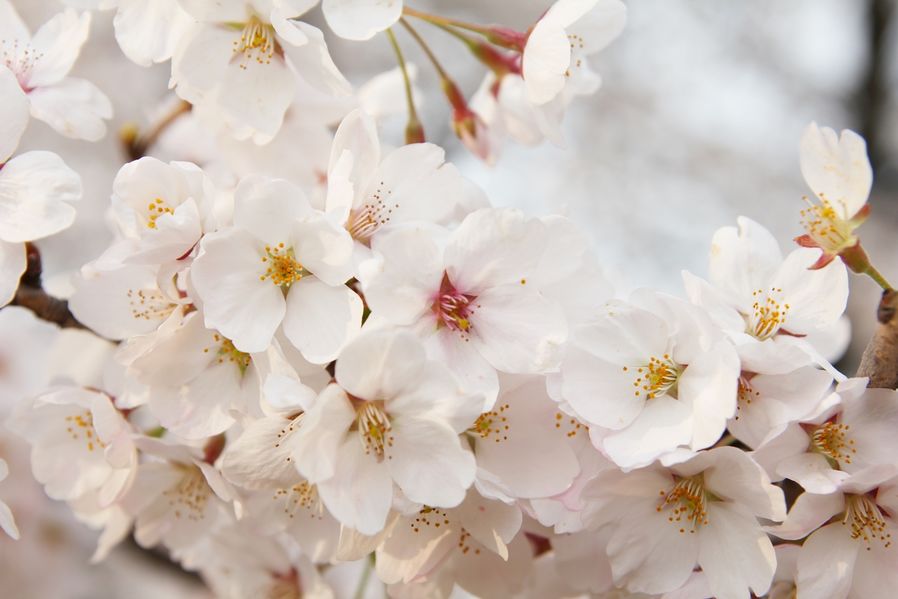
Canon EOS 550D | f/5.0 | iso 100 | 2015:04:08 17:12:10 | Flash did not fire, compulsory flash mode | 50mm
They flower in red and green. Are they originally like this? It looks so strange to me. hahaha They seem much more beautiful than ones at other festivals. There are especially many trees that look at least 100 years old, so the width and height of blooming flowers are overwhelming.
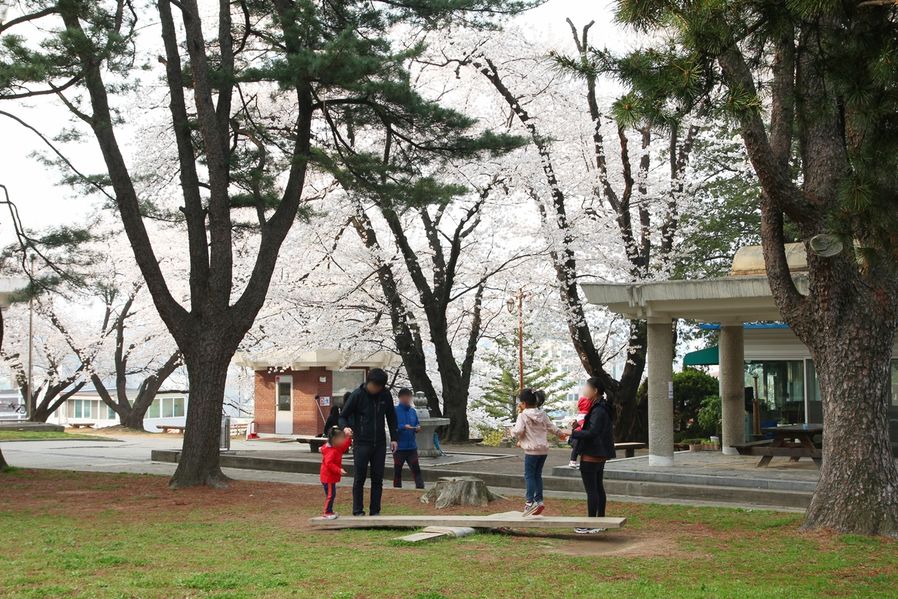
Canon EOS 550D | f/8.0 | iso 100 | 2015:04:08 17:15:41 | Flash did not fire, compulsory flash mode | 30mm
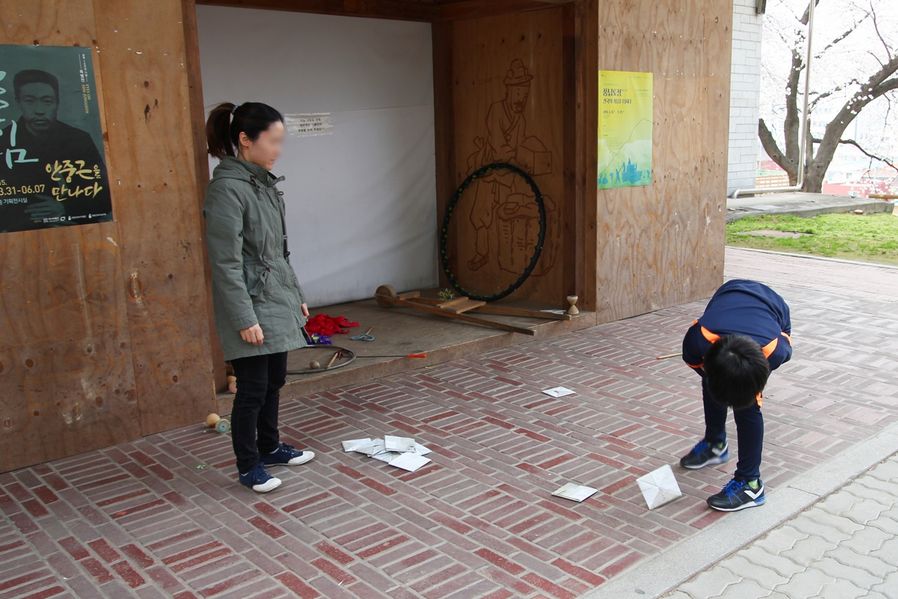
Canon EOS 550D | f/5.0 | iso 100 | 2015:04:08 16:58:04 | Flash did not fire, compulsory flash mode | 19mm
On the sunny day, I'm enjoying afternoon playing with family. It's so beautiful that I would like to stay for a while with my laptop every weekend.
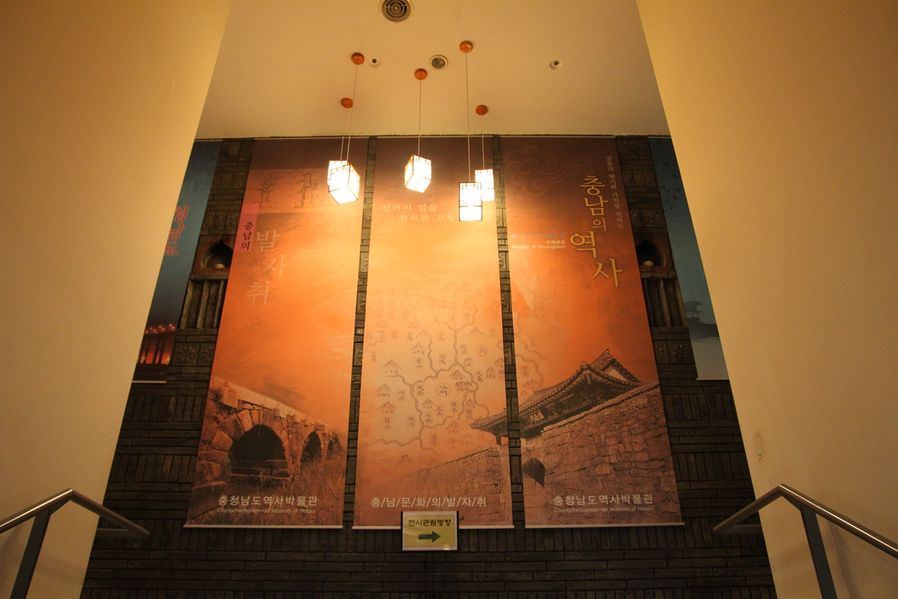
Canon EOS 550D | f/4.0 | iso 1600 | 2015:04:08 16:59:15 | Flash did not fire, compulsory flash mode | 17mm
Another attraction is the Chungnam Museum of History. Cherry blossoms are surrounding the museum. This museum displays historical relics and materials related to Chungcheongnam-do. Cherry Blossom Cultural Festival is held in every April. The museum class for the youth, various experience and explore programs are run in July and December.
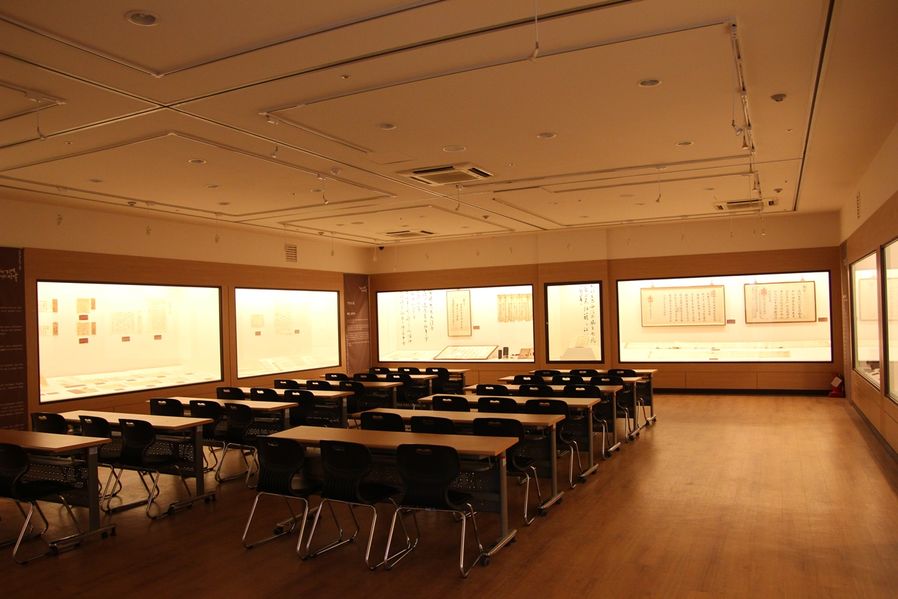
Canon EOS 550D | f/4.0 | iso 1250 | 2015:04:08 17:05:10 | Flash did not fire, compulsory flash mode | 17mm
Let's take a look inside the gallery. Important folklore materials and treasures including diverse documents and pictures related to Chungcheongnam-do are put on exhibition. I went into the gallery to watch 'Portrait of Yun Jeung and Yeongdang Gijeok(影堂紀蹟) (Treasure No.1495)' but it's not exhibited now. They might be rented out to other museums. I will visit here again when I come back to Gongju.
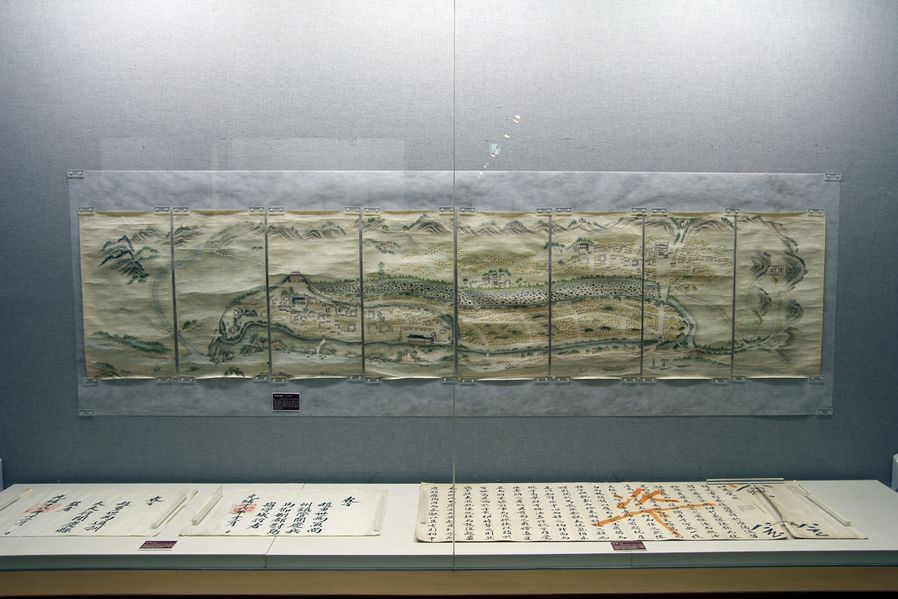
Canon EOS 550D | f/3.5 | iso 160 | 2015:04:08 17:01:27 | Flash did not fire, compulsory flash mode | 20mm

Canon EOS 550D | f/4.0 | iso 1000 | 2015:04:08 17:04:13 | Flash did not fire, compulsory flash mode | 19mm
I like this kind of photo exhibition. There are pictures of Chungcheongnam-do in Joseon Dynasty and Japanese Colonial Period. It's nice to watch because I can imagine people and their life in those time.
+ Address : 284-1, Jung-dong, Gongju-si, Chungcheongnam-do
+ Telephone : 041-856-8608
+ Open Hour : 9 am ~ 6 pm (Monday Closed)
+ Entrance Fee : Free
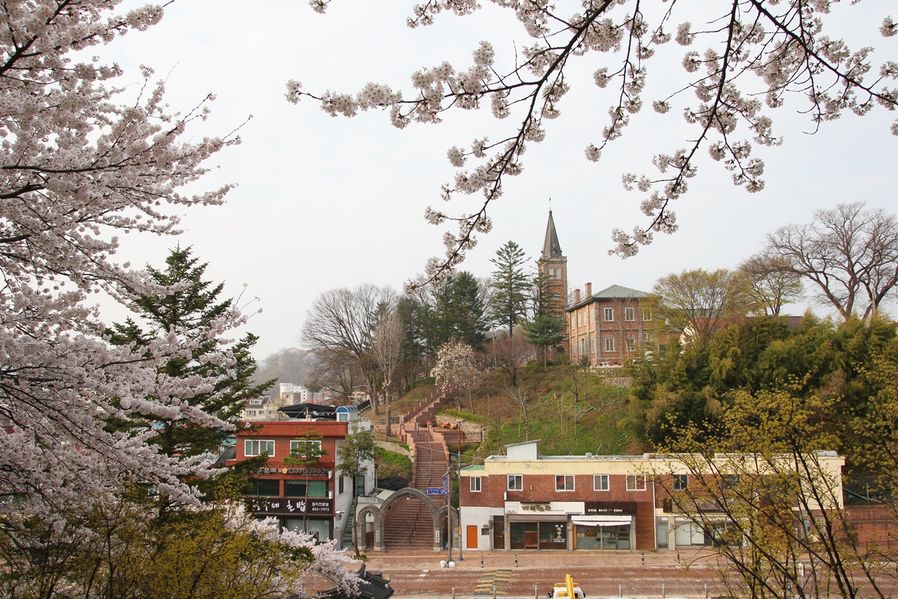
Canon EOS 550D | f/8.0 | iso 100 | 2015:04:08 17:16:58 | Flash did not fire, compulsory flash mode | 17mm
Looking at the hill across from the museum, there is wonderful Gongju Jungdong Catherdral. Let's cross the street to the cathedral.
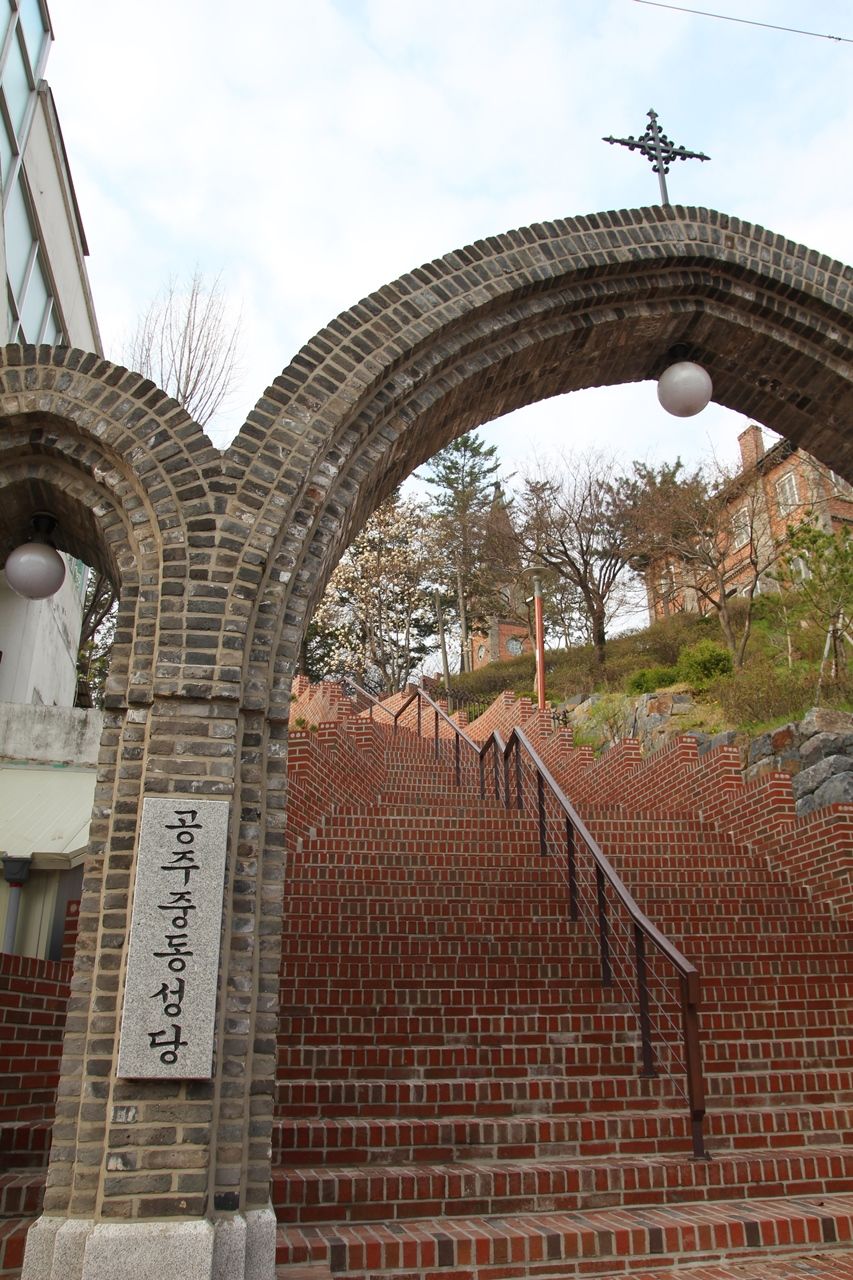
Canon EOS 550D | f/8.0 | iso 100 | 2015:04:08 17:18:41 | Flash did not fire, compulsory flash mode | 17mm
Upstairs look unique and special. Originally it had been built by French Father Peter in 1898 during the Joseon Dynasty. The main hall with the Gothic style of bell tower, parish house, and nunnery were rebuilt in 1937 during the Japanese Colonial Period. Now, the building has modern style.
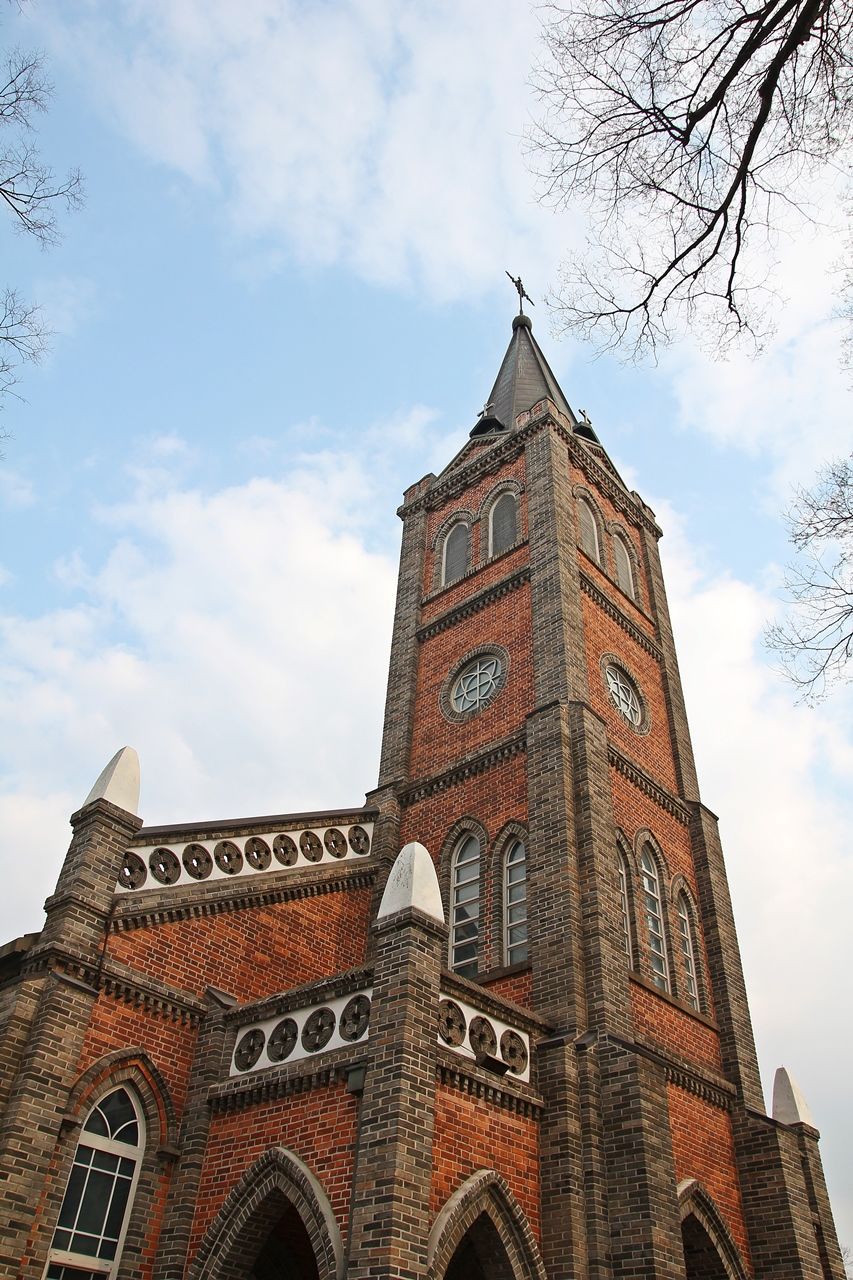
Canon EOS 550D | f/8.0 | iso 100 | 2015:04:08 16:50:07 | Flash did not fire, compulsory flash mode | 17mm
The cathedral is not quite large but its yard is narrow. It's hard to take a picture of whole building with my camera's angle of view. If I want to do it, I should determine to either fly in the sky or fall over a cliff. Hahaha A High bell tower on the top is impressive. Windows of main entrance are decorated in arch shape. They seem to emphasize the verticality. I want to go into the cathedral but it's closed. I have been many cathedrals but it's the first time to see a cathedral that both front and back doors are locked. Maybe I had good chances at other cathedrals. Anyway…
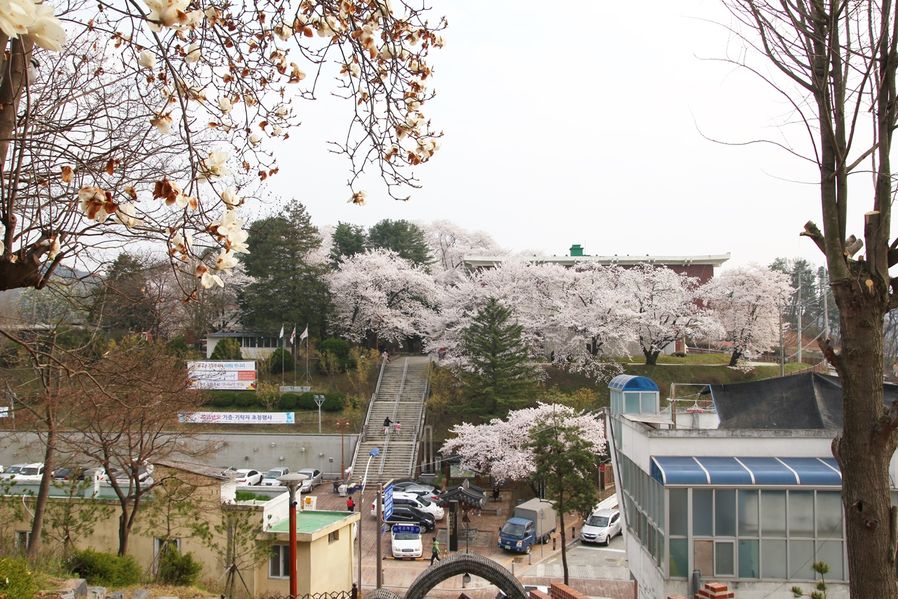
Canon EOS 550D | f/8.0 | iso 100 | 2015:04:08 17:20:19 | Flash did not fire, compulsory flash mode | 19mm
Cherry blossoms around the Chungnam History Museum look like this from the cathedral. I came here from there but I couldn't refuse to go back to the museum due to this wonderful view. Then I took a cup of coffee. There is a wide free parking lot at the entrance so it's easy to park.
+ Address : 31, Jung-dong, Gongju-si, Chungcheongnam-do
+ Telephone : 041-856-1033









